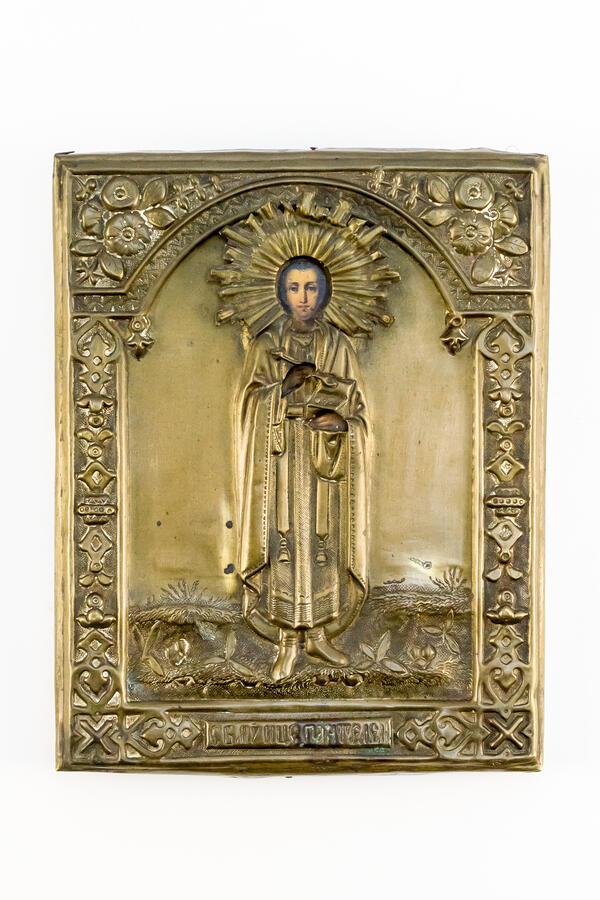The icon “The Holy Great Martyr Panteleimon” is a special icon, intended for the quiet prayer of a monk in his own monastic cell. It was painted in the first half of the 19th century.
The Great Martyr Panteleimon is revered in the Orthodox Church as a formidable saint, the patron saint of soldiers. This can be derived from his first name Pantoleon, which means “lion in everything.” The second name given to him when he was baptized is Panteleimon, that is, “all-merciful.” It speaks of the martyr’s healing gift. Western Christians consider the saint to be the patron saint of doctors.
The connection between these two patronages is evident since warriors are usually the ones who need a doctor most of all, because they get wounds more often than other people do. Therefore, Christians who participate in the spiritual struggle also resort to Saint Panteleimon with a request to heal their inner soul sins. The priests also call out his name when they perform the sacrament of the blessing oil or water and when they pray for those who are ill.
The icon belongs to the type of “podokladnitsa” (“under-revetment”), that is, most of the painting is hidden under the metal revetment. The artist made it from a single sheet of brass — an alloy of copper and zinc. He used special tools: punches and a liner. A punch is a small press made of extra strong steel that is capable of stamping and marking metal. It can be used to punch surfaces, mark and perform other work. A liner is a chased tool with a sharp end in the form of an awl, it was used to emboss dots and make backgrounds with a nice slightly rough relief. The artisan made this icon using the technique of high-relief embossing, that is, some parts considerably project above the surface and create a play of light and shadow.
A brass revetment covers the entire front side of the icon. The artisan made holes only over the most important parts of the figure — the face and hands. He painted the faces with oil paint on a special chalk ground called gesso. The use of oil paint and a patterned revetment around the figure correspond to the style of that time: at the beginning of the 19th century, such elements were quite common in icon painting.
The shape of the pattern was influenced by the Empire style common at that time. It is also called imperial style. It originated in France and started from the cult of Napoleon. Its main task was to glorify the greatness and permanence of power. Hence special artistic forms appeared: the art of that time was distinguished by its monumentality and clarity of compositions, orientation towards the ideals of antiquity. The artists borrowed elements from classical architecture for the ornaments and tried not to overload their works with details.
The Great Martyr Panteleimon is revered in the Orthodox Church as a formidable saint, the patron saint of soldiers. This can be derived from his first name Pantoleon, which means “lion in everything.” The second name given to him when he was baptized is Panteleimon, that is, “all-merciful.” It speaks of the martyr’s healing gift. Western Christians consider the saint to be the patron saint of doctors.
The connection between these two patronages is evident since warriors are usually the ones who need a doctor most of all, because they get wounds more often than other people do. Therefore, Christians who participate in the spiritual struggle also resort to Saint Panteleimon with a request to heal their inner soul sins. The priests also call out his name when they perform the sacrament of the blessing oil or water and when they pray for those who are ill.
The icon belongs to the type of “podokladnitsa” (“under-revetment”), that is, most of the painting is hidden under the metal revetment. The artist made it from a single sheet of brass — an alloy of copper and zinc. He used special tools: punches and a liner. A punch is a small press made of extra strong steel that is capable of stamping and marking metal. It can be used to punch surfaces, mark and perform other work. A liner is a chased tool with a sharp end in the form of an awl, it was used to emboss dots and make backgrounds with a nice slightly rough relief. The artisan made this icon using the technique of high-relief embossing, that is, some parts considerably project above the surface and create a play of light and shadow.
A brass revetment covers the entire front side of the icon. The artisan made holes only over the most important parts of the figure — the face and hands. He painted the faces with oil paint on a special chalk ground called gesso. The use of oil paint and a patterned revetment around the figure correspond to the style of that time: at the beginning of the 19th century, such elements were quite common in icon painting.
The shape of the pattern was influenced by the Empire style common at that time. It is also called imperial style. It originated in France and started from the cult of Napoleon. Its main task was to glorify the greatness and permanence of power. Hence special artistic forms appeared: the art of that time was distinguished by its monumentality and clarity of compositions, orientation towards the ideals of antiquity. The artists borrowed elements from classical architecture for the ornaments and tried not to overload their works with details.



